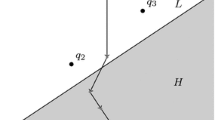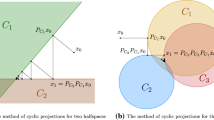Abstract
We discuss recent positive experiences applying convex feasibility algorithms of Douglas–Rachford type to highly combinatorial and far from convex problems.

















Similar content being viewed by others
Notes
Here indices are understood modulo N. That is, C N+1:=C 1.
In this context, “feasibility” and “satisfiability” can be used interchangeably.
See http://carma.newcastle.edu.au/DRmethods/comb-opt/2cycle.html for an animated version.
Also known as McMahon Squares in honour of the great English combinatorialist, Percy MacMahon, who examined them nearly a century ago.
Pulkit Bansal did this as a 2010 NSERC summer student with Heinz Bauschke and Xianfu Wang.
Japanese, being based on ideograms, does not lead itself to anagrams, crosswords or other word puzzles; this in part explains why so many good numeric and combinatoric games originate in Japan.
top1465: http://magictour.free.fr/top1465
Gordon Royle: http://school.maths.uwa.edu.au/~gordon/sudokumin.php
reglib-1.3: http://hodoku.sourceforge.net/en/libs.php
ksudoku16/25: http://carma.newcastle.edu.au/DRmethods/comb-opt/
Gurobi Sudoku model: http://www.gurobi.com/documentation/5.5/example-tour/node155
Schaad’s web-based solver: https://people.ok.ubc.ca/bauschke/Jason/
For the five solutions: http://carma.newcastle.edu.au/DRmethods/comb-opt/nasty_nonunique.txt
If x n is the current iterate, x ∗ the solution, and m=max n ∥P D x n −x ∗∥, ∥P D x n −x ∗∥/m is plotted against n.
QR (quick response) codes are two-dimensional bar codes originally designed for use in the Japanese automobile industry. Their data is typically encoded in either numerical, alphanumerical, or binary formats.
References
Douglas, J., Rachford, H.: On the numerical solution of heat conduction problems in two and three space variables. Trans. Am. Math. Soc. 82(2), 421–439 (1956)
Lions, P., Mercier, B.: Splitting algorithms for the sum of two nonlinear operators. SIAM J. Numer. Anal. 964–979 (1979)
Combettes, P.: Solving monotone inclusions via compositions of nonexpansive averaged operators. Optimization 53(5–6), 475–504 (2004)
Borwein, J., Zhu, Q.: Techniques of Variational Analysis. CMS Books in Mathematics. Springer, New York (2005)
Borwein, J., Sims, B.: The Douglas–Rachford algorithm in the absence of convexity. In: Fixed-Point Algorithms for Inverse Problems in Science and Engineering, pp. 93–109. Springer, Berlin (2011)
Bauschke, H., Combettes, P., Luke, D.: Finding best approximation pairs relative to two closed convex sets in Hilbert spaces. J. Approx. Theory 127(2), 178–192 (2004)
Bauschke, H., Borwein, J.: On the convergence of von Neumann’s alternating projection algorithm for two sets. Set-Valued Anal. 1(2), 185–212 (1993)
Combettes, P., Pesquet, J.: A Douglas–Rachford splitting approach to nonsmooth convex variational signal recovery. IEEE J. Sel. Top. Signal Process. 1(4), 564–574 (2007)
Gandy, S., Yamada, I.: Convex optimization techniques for the efficient recovery of a sparsely corrupted low-rank matrix. J. Math for Industry 2(5), 147–156 (2010)
Steidl, G., Teuber, T.: Removing multiplicative noise by Douglas–Rachford splitting methods. J. Math. Imaging Vis. 36(2), 168–184 (2010)
Svaiter, B.F.: On weak convergence of the Douglas-Rachford method. SIAM J. Control Optim. 49(1), 280–287 (2011)
Yamada, I., Gandy, S., Yamagishi, M.: Sparsity-aware adaptive filtering based on a Douglas–Rachford splitting. In: Proc. EUSIPCO, pp. 1929–1933 (2011)
Bauschke, H., Combettes, P.: Convex Analysis and Monotone Operator Theory in Hilbert Spaces. Springer, New York (2011)
Opial, Z.: Weak convergence of the sequence of successive approximations for nonexpansive mappings. Bull. Am. Math. Soc. 73(4), 591–597 (1967)
Borwein, J.M., Tam, M.K.: The cyclic Douglas–Rachford method for inconsistent feasibility problems. Preprint (2013). arXiv:1310.2195
Borwein, J., Tam, M.: A cyclic Douglas-Rachford iteration scheme. J. Optim. Theory Appl. (2013). doi:10.1007/s10957-013-0381-x
Bauschke, H., Matoušková, E., Reich, S.: Projection and proximal point methods: convergence results and counterexamples. Nonlinear Anal.: Theory Methods Appl. 56(5), 715–738 (2004)
Borwein, J., Vanderwerff, J.: Convex Functions: Constructions, Characterizations and Counterexamples. Encyclopedia of Mathematics and Its Applications. Cambridge University Press, Cambridge (2010)
Aragón Artacho, F., Borwein, J.: Global convergence of a non-convex Douglas–Rachford iteration. J. Glob. Optim. (2012), 17 pp. doi:10.1007/s10898-012-9958-4
Hesse, R., Luke, D.: Nonconvex notions of regularity and convergence of fundamental algorithms for feasibility problems. Preprint (2012). arXiv:1205.0318v1
Bauschke, H., Luke, D., Phan, H., Wang, X.: Restricted normal cones and sparsity optimization with affine constraints. Found. Comput. Math. (2012), 21 pp. doi:10.1007/s10208-013-9161-0
Babu, P., Pelckmans, K., Stoica, P., Li, J.: Linear systems, sparse solutions, and Sudoku. IEEE Signal Process. Lett. 17(1), 40–42 (2010)
Aragón Artacho, F., Borwein, J., Tam, M.: Douglas–Rachford feasibility methods for matrix completion problems (2013). Preprint arXiv:1308.4243
Elser, V., Rankenburg, I.: Deconstructing the energy landscape: constraint-based algorithms for folding heteropolymers. Phys. Rev. E 73(2), 026,702 (2006)
Elser, V., Rankenburg, I., Thibault, P.: Searching with iterated maps. Proc. Natl. Acad. Sci. 104(2), 418–423 (2007)
Bauschke, H., Combettes, P., Luke, D.: Phase retrieval, error reduction algorithm, and Fienup variants: a view from convex optimization. J. Opt. Soc. Am. A 19(7), 1334–1345 (2002)
Bauschke, H., Combettes, P., Luke, D.: Hybrid projection–reflection method for phase retrieval. J. Opt. Soc. Am. A 20(6), 1025–1034 (2003)
Johnson, C.: Matirx completion problems: a survey. In: Proc. Sympos. Appl. Math., pp. 171–198 (1990)
Schaad, J.: Modeling the 8-queens problem and Sudoku using an algorithm based on projections onto nonconvex sets. Master’s thesis, Univ. British Columbia (2010)
Gravel, S., Elser, V.: Divide and concur: a general approach to constraint satisfaction. Phys. Rev. E 78(3), 036706 (2008)
Garey, R., Johnson, D.: Computers and Intractability: A Guide to the Theory of NP-Completeness. A Series of Books in the Mathematical Sciences. Freeman, New York (1979)
Takenaga, Y., Walsh, T.: Tetravex is NP-complete. Inf. Process. Lett. 99, 171–174 (2006)
Bansal, P.: Code for solving Tetravex using Douglas–Rachford algorithm (2010). http://people.ok.ubc.ca/bauschke/Pulkit/pulkitreport.pdf
Takayuki, Y., Takahiro, S.: Complexity and completeness of finding another solution and its application to puzzles. IEICE Trans. Fundam. Electron. Commun. Comput. Sci. 86(5), 1052–1060 (2003)
Nagao, T., Ueda, N.: NP-completeness results for nonogram via parsimonious reductions. Depart. Computer Science, Tokyo Inst. Technol. Tech. Rep. TR96-0008 (2012). CiteSeerX doi:http://citeseerx.ist.psu.edu/viewdoc/summary?doi=10.1.1.57.5277
van Rijn, J.: Playing games: The complexity of Klondike, Mahjong, nonograms and animal chess. Master’s thesis, Leiden Inst. of Advanc. Computer Science, Leiden Univ. (2012)
Hardy, G., Littlewood, J., Pólya, G.: Inequalities. Cambridge Mathematical Library. Cambridge University Press, Cambridge (1952)
Elser, V.: Private communication. August 27th (2012)
Bosch, R.: Painting by numbers. Optima 65, 16–17 (2001)
Bačák, M., Searston, I., Sims, B.: Alternating projections in CAT(0) spaces. J. Math. Anal. Appl. 385(2), 599–607 (2012)
Searston, I., Sims, B.: Nonlinear analysis in geodesic metric spaces, in particular CAT(0) spaces. Preprint (2013)
Acknowledgements
We wish to thank Heinz Bauschke, Russell Luke, Ian Searston and Brailey Sims for many useful insights. We would also like to thank the anonymous referee for their helpful suggestions. Example 2.1 was provided by Brailey Sims.
Author information
Authors and Affiliations
Corresponding author
Additional information
Communicated by Michel Théra.
Rights and permissions
About this article
Cite this article
Aragón Artacho, F.J., Borwein, J.M. & Tam, M.K. Recent Results on Douglas–Rachford Methods for Combinatorial Optimization Problems. J Optim Theory Appl 163, 1–30 (2014). https://doi.org/10.1007/s10957-013-0488-0
Received:
Accepted:
Published:
Issue Date:
DOI: https://doi.org/10.1007/s10957-013-0488-0




